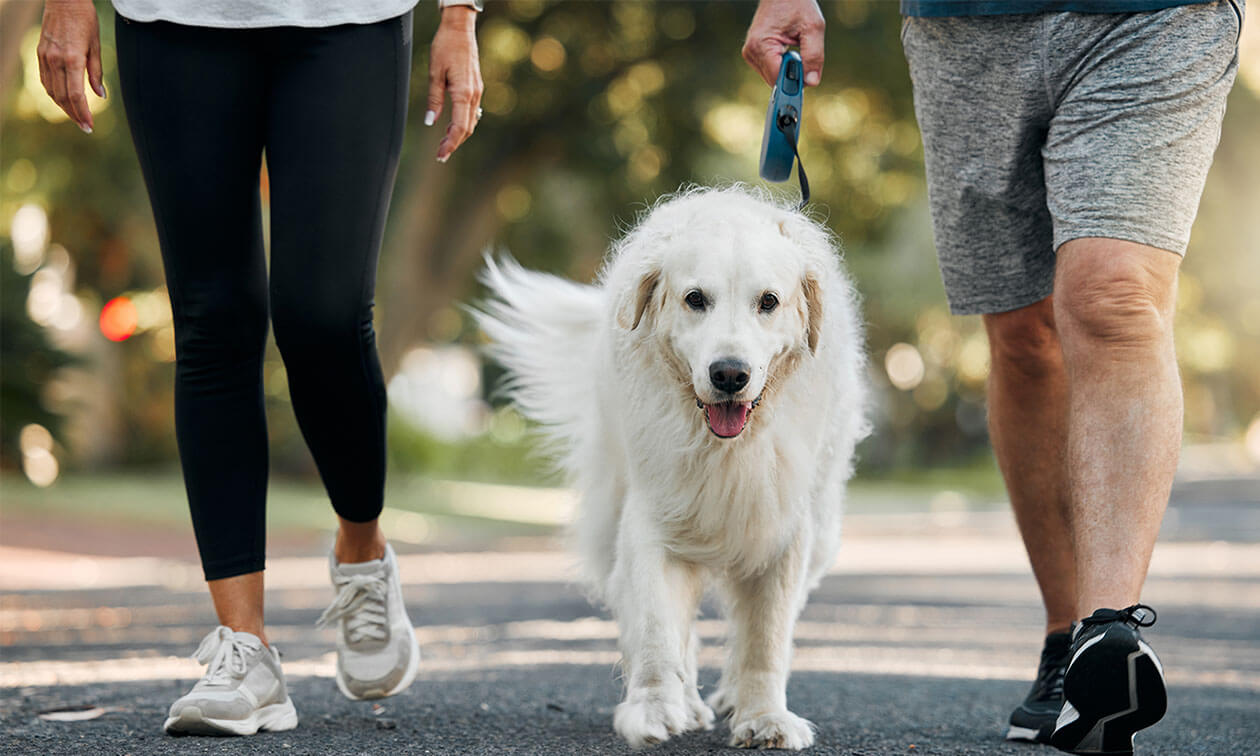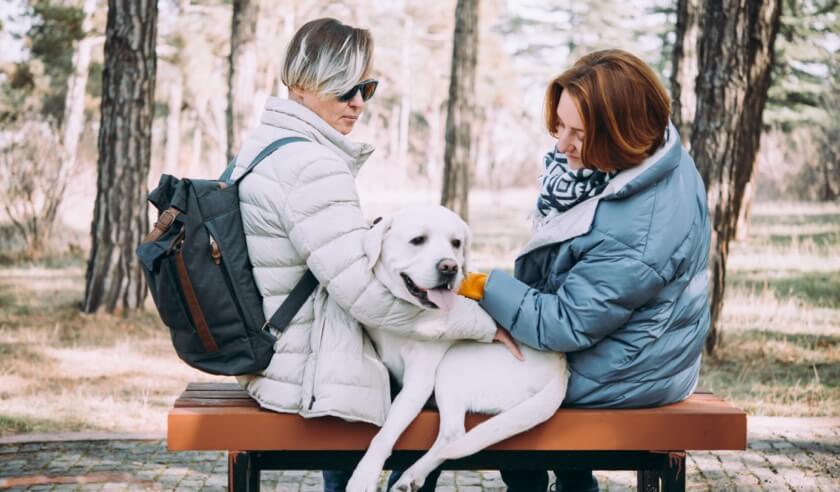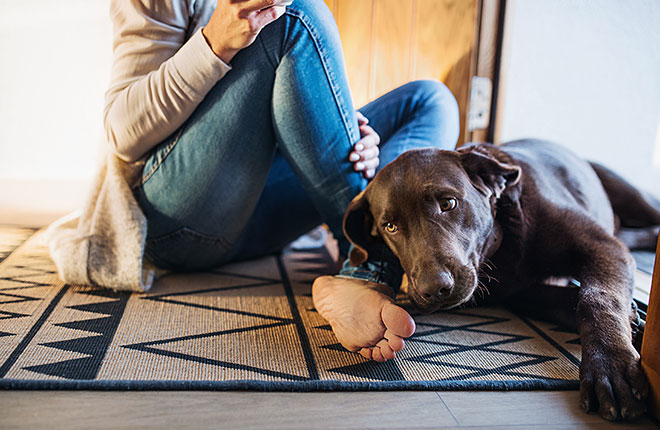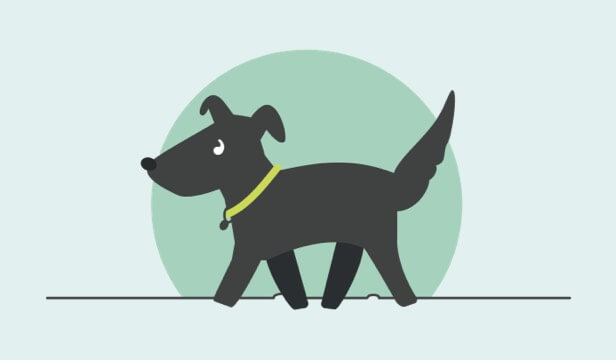If your dog has osteoarthritis or OA, or you suspect they might, you're not alone. It affects nearly 40% of all dogs1 and is a common cause of chronic pain in dogs. OA does not only impact older dogs – it affects dogs of all ages, sizes, and breeds2. OA can affect any dog, but the good news is that much can be done to help a dog with OA pain have a good quality of life for years to come.
Speak with your veterinarian about options for managing your dog’s OA pain. There are new medications to manage OA pain, and, weight control along with environmental modifications and exercise can play a role in the management of OA pain. Exercise can help improve joint mobility, reduce pain and inflammation, strengthen your dog's muscles, and keep them active — not to mention help with weight loss (or maintaining a healthy weight) and boosting the bond between you.
This article will provide you with guidance to set up a safe and effective exercise program for a dog with OA.
Principles of a Therapeutic Home Exercise Program for your Osteoarthritic Dog
Canine Arthritis Resources and Education (CARE) is dedicated to helping veterinarians and dog owners work to combat osteoarthritis pain. Here's a summary of the 7 principles for therapeutic exercise3:
- Building blocks. Therapeutic exercises start with a foundation of basic commands, including sit, down, stand, stay/wait, here/touch, shake, and heal. If your dog does not know these commands, work with a reputable trainer to teach them.
- Start slow and easy. To ensure there is not too much stress on your dog's body, start all exercises on an easy level.
- Correct form matters. Training muscles to do a task or maintain a certain posture creates muscle memory, so the movement or position becomes second nature. If that training includes incorrect form, it's memorized that way and can actually do damage. Think about sitting slumped over — this becomes your default unless you make a conscious effort to correct your posture until it becomes second nature.
- Watch for fatigue. This is true during and after exercise. If your dog seems less enthusiastic or is sitting down/laying down more, it may be time for a break.
- Progression matters. The body adapts to the forces placed upon it as long as they are not so great that they cause injury. This principle is used to increase strength, endurance, and flexibility, but it has to be done gradually. Therapeutic exercises are progressed by increasing one of the following:
- Time
- Distance
- Intensity
- Repetitions
- Frequency
- Dogs get sore too. DOMS stands for Delayed Onset Muscle Soreness and can develop in dogs after they exercise, especially when progressing through a therapeutic exercise program. It is the soreness associated with the repair process in muscle adaptation to strength training. Because we do not want dogs to get DOMS, exercises should start slow and easy.
- Rest days are OK. They may be essential to allow the body to recover from training. Make sure to add them into your plans.
Exercises for a Dog with Osteoarthritis
Once the basic obedience commands are mastered, consult with your veterinarian to develop a therapeutic exercise plan best suited for your dog's needs. This is important because they may vary depending on what part of your dog's body is affected and how severe the OA is. In addition, all new exercises should be introduced slowly to prevent causing stress or injury.
It’s essential to choose low-impact exercises that won't put too much stress on your dog's joints. Here are some exercises you can consider for a dog with OA pain:
- Walking. Start with short walks and gradually increase the time and distance as your dog's condition improves. Try finding a level trail that doesn't have much of an incline. If your dog is particularly stiff when getting up, start the routine with a short, low-impact walk (i.e., on a smooth, flat surface) just to get their joints moving.
- Swimming. The buoyancy of the water reduces the pressure on the joints, making it easier for dogs to move and exercise. The cohesion and turbulence of water provide a resistant force when moving through it, helping increase muscle strength, endurance, and the range of motion of the joints. In addition, the increased water temperature in underwater treadmills or pools helps increase blood flow to the limbs and provides a soothing environment. The conclusion of one study stated that swimming over two days, eight weeks continually, can improve the function of OA joints3. If your dog has not swam before you will need to slowly get them used to it. You can also try an underwater treadmill that would be found at a rehabilitation center.
- Range of motion exercises. They can help improve joint mobility in dogs with osteoarthritis. Gently move your dog's joints through their full range of motion, being careful not to cause any pain or discomfort.
- Stretching. Gentle stretching can also help improve joint mobility and flexibility in dogs with osteoarthritis. Focus on stretching the muscles around the affected joints, such as the hips and knees. Ask your veterinarian to show you some range of motion and stretching exercises you can try at home.
- Treadmill. If your dog is not able to walk comfortably, a treadmill can be a good option. Ask a rehabilitation specialist for advice on if treadmill exercises are right for you dog and which treadmill to get, or you can take your dog to rehab for this activity. It allows you to control the speed and incline, and the low-impact surface is easier on your dog's joints. Treadmills designed for humans can technically be used for dogs, but it is important to use caution and take certain factors into consideration. Does it have a large enough walking surface to accommodate your dog's size and gait? Are there sturdy side rails or barriers to prevent your dog from falling off? Can it start at a slow pace and be gradually increased to allow your dog to get comfortable with the treadmill? Once you address these questions, slowly work with your dog to get them used to walking on the treadmill and never leave them unattended on the treadmill.
- Indoor games and activities. These may be a way to keep your dog entertained while managing their mobility. Try playing hide and seek or use interactive toys/puzzles to spark activity. Providing a favorite food treat (and try low calorie treats such as carrots and snap peas) afterward will make it even more enjoyable for your canine companion. Just be careful not to push too hard and to watch for signs of your dog slowing down, becoming disengaged, laying down or even panting more. Play should take into account the part of your dog's body that is affected and their current mobility.
If you are uncomfortable or want advice doing some exercise with your dog, talk to your veterinarian. Your veterinarian may recommend seeing a veterinary rehab/pain specialist that can do physical therapy work to help with your dog’s OA pain.
Working with your veterinarian to develop a safe and effective exercise plan for your dog, along with medication for OA pain management, achieving proper weight control, and making environmental modifications so your they can maneuver more easily, will ensure that your canine best friend has the best quality of life, and isn't so negatively impacted by their osteoarthritis.
ZPC-02571R1
IMPORTANT SAFETY INFORMATION: For use in dogs only. Women who are pregnant, trying to conceive or breastfeeding should take extreme care to avoid self-injection. Hypersensitivity reactions, including anaphylaxis, could potentially occur with self-injection. Librela should not be used in breeding, pregnant or lactating dogs. Librela should not be administered to dogs with known hypersensitivity to bedinvetmab. The most common adverse events reported in a clinical study were urinary tract infections, bacterial skin infections and dermatitis. See full Prescribing Information.
INDICATIONS: For the control of pain associated with osteoarthritis in dogs.
See the Client Information Sheet for more information about Librela.
Wright A, Amodie AM, Cernnicchiaro N, et al. Identification of canine osteoarthritis using an owner-reported questionnaire and treatment monitoring using functional mobility tests. J Small Anim Pract. 2022;63(8):609-618.
Anderson KL, Zulch H, O’Neill DG, Meeson RL, Collins LM. Risk factors for canine osteoarthritis and its predisposing arthropathies: a systematic review. Front Vet Sci. 2020;7:200. doi:10.3389/fvets.2020.00220
- Nganvongpanit K, Tanvisut S, Yano T, Kongtawelert P. Effect of swimming on clinical functional parameters and serum biomarkers in healthy and osteoarthritic dogs. ISRN Vet Sci. 2014 Jan 9;2014:459809. doi: 10.1155/2014/459809. PMID: 24977044; PMCID: PMC4060742.






